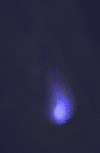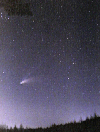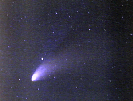Months with Hale-Bopp Comet
In order to enjoy comets, one must have the policy of "See it with
the best effort when it can be seen at all."
It was on Sunday February 9, 1997 very early in the morning that
we, Sue and shig, saw the Hale-Bopp comet for the first time. We
got up at 2 am at our mountain cabin at Mt. Yatsugatake and set out at
2:30 am into the chill of -6 degrees centigrade. We drove 45 minutes to
the other eastern side of the mountain, to Meadow Park above Kiyosato
where the east side was wide open.
2月9日早朝、清里の上にある「まきば公園」まで行き、-6度の雪の中で初めて水滴状に青く光るHale-Bopp彗星を見ました。丁度「矢座」のやじりの位置で火矢のようでした。
While Sue stayed in the car for the minimum warmth, Shig set up the
telescope in the snow and tried to identify constellations. A glittering
man-made satellite passed through the sky full of stars. The reason
why Shig had difficulty in identifying constellations was that the first
mangitude star Vega in Lyra looked much dimmer than expected because it
was still low in the sky. Once Vega was found, Cygnus, the constellation
of Swan was easily identified with its right wing still below the horizon.
At its beak was a third mangitude star Albireo, or the beta star of Cygnus.
Below this beta star, we could see with a binocular the Hale-Bopp comet
rising from haze on the horizon. It was at the lower tip of Sagitta, or
Arrow constellation. The comet looked like a dimly glowing bluish water
drop, or more poetically, like the bluish flaming head of a fire-arrow.
With a 100 mm astronomical telescope, a faint tail could be seen.
We could not stay long in the chill and left there at 4:30 am into the
warm bed again. We took about 20 pictures with a high-sensitivity film
of ASA3200 but none came out well. Shig thought wrongly that 30 second
exposure must be enough and in a few shots with 120 seconds the comet moved
on the film because we did not set the tracking mechanism.
An English Haiku poem at that scene was;
The Hale-Bopp comet; / Th'bluish flaming arrowhead / on th'chilled horizon.
Next week, Aiki, our son, and Shig got up early in our home at Hachioji,
a western outskirt of Tokyo, and drove to a near-by park to see the comet.
To our surprise, we could see the blue sky before the dawn because the
direction of the comet, east north-east, was above nightless Tokyo. Hence;
Dimly glows the comet / low on nightless Tokyo light. / Wish it were
higher.
On February 20, Shig got up early at Hachioji alone because
no one else followed, and tried the idea of taking pictures by opening a 28 mm wide
lens for 60 seconds to minimize movement of the comet on the film.
Fortunately, the moon has soon set. It worked and the film captured the
comet in the blue sky. The temperature was not too low but around zero
degree.
followed, and tried the idea of taking pictures by opening a 28 mm wide
lens for 60 seconds to minimize movement of the comet on the film.
Fortunately, the moon has soon set. It worked and the film captured the
comet in the blue sky. The temperature was not too low but around zero
degree.
八王子でも見ましたが、東京の灯りの真上になるため、夜明け前でも青空が見え、彗星を見るには適していません。それでも広角レンズで撮影してみました。
An unusually cold weather came to Japan in the weekend of February 22-23.
But the cold weather means the clear sky in Japan. We, Sue and Shig, of
course went to Mt. Yatsugatake on Saturday February 22. But the mountains
looked white with snow and we did not want to drive next morning as far
as Meadow Park because the mountain road was covered with much snow. During
the day time on Saturday, we looked around the lower altitude foot of the
mountain for a place where the north-east side was open. Finally we found
a farm with a good view within 20 minute downhill drive from our cabin.
On Sunday February 23 morning, we got up at 3:45 am. The sky
was clear but the temperature was surprisingly -16 degrees. But when we drove downhill to
the farm at the foot of Mt. Yatsugatake, the temperature was only
-6 degrees there probably because heat from the sunshine in the day time
had been stored in the ground. The comet was so bright that it could be
easily identified with the naked eye. The tail could be seen with the 100
mm telescope. We took some pictures through the telescope with 60 -
120 second exposure this time with tracking.
temperature was surprisingly -16 degrees. But when we drove downhill to
the farm at the foot of Mt. Yatsugatake, the temperature was only
-6 degrees there probably because heat from the sunshine in the day time
had been stored in the ground. The comet was so bright that it could be
easily identified with the naked eye. The tail could be seen with the 100
mm telescope. We took some pictures through the telescope with 60 -
120 second exposure this time with tracking.
異常寒波の中、八ヶ岳山麓の農場から望遠鏡にカメラを接続して撮影しました。
In the weekend of March 8 and 9, we invited Mr. Brian Dougherty,
Chairman of Wink, to our cabin in Mt. Yatsugatake to show him around the
rural Japan. Seeing an ideal sky on Saturday evening, Shig declared that
he would get up early on Sunday morning to see the comet. Hence;
I'll get up in the chill, / regardless of what you do, / to watch
the comet.
After a second of pondering, Brian-san told Shig to wake him up. Shig
woke up at 3:45 am on Sunday morning and saw a beautiful night sky although
clouds were coming. Shig woke up Brian-san and we went out into the chill
at 4 am only to find that the whole sky had been covered by the cloud in
15 minutes. Shig felt very responsible. But hoping a luck we drove for
20 minutes downhill to a farm. There were fewer clouds but still we could
not hope to see the comet. A man waiting there with a telescope said that
the clouds were increasing. Shig thought it was better but he said worse.
So Shig thought that the clouds must be generated by the mountain and we
might be able to see the comet if we drove further downhill. We drove down
to another farm and we could see the comet ! We drove further down to the
highway Route 20 and saw the comet much better. Brian-san enjoyed his first
view of the comet with bright white tail both with the naked eye and with
a binocular. The comet was already too big for a telescope.
3月9日ー10日の週末にWink会長のBrian Dougherty氏を八ヶ岳の山小屋にお招きし、土曜9日夜の空が晴れていたので翌朝起こす約束をしました。日曜朝3:45
amに星降る夜空を確認してから客人を起こし、4 amに外に出たら全天が雲に覆われ星一つ見えなくなっていました。大いに責任を感じて、雲は山から発していると考えて車でどんどん下って行ったら雲が少なくなり、幸い客人に初めての彗星を見て頂きました。
In mid-March, Shig was frustrated becasue the weather was bad every
weekend. On clear weekday mornings he woke up early several times to look
at the comet near our home at Hachioji. The comet was getting brighter
and the tail was now visible with the naked eye but it was apparent that
the tailing end was masked by light from Tokyo.
Then, according to astronomical magazines, the best timing to see the
comet shifted from one hour before sunrise to one hour after sunset, although
weather didn't allow us to see it any way. In a evening in the last week
of March when Shig returned from work and was picked up by Sue at the station,
the sky was clear and some stars were visible. We changed the way to stop
at a mountain pass. We looked at north-west and instantly found the comet with the naked eye.
We returned home to bring binoculars and took a son and a neighbor to come
back to the pass. With a binocular, the comet was seen with the tail
above the light of Hachioji, much better than Tokyo light.
We looked at north-west and instantly found the comet with the naked eye.
We returned home to bring binoculars and took a son and a neighbor to come
back to the pass. With a binocular, the comet was seen with the tail
above the light of Hachioji, much better than Tokyo light.
3月下旬になると彗星は日没後に見えるはずでした。或る日ワイフに迎えに来て貰った最寄駅で空を見ると星が見えたので、峠から北西の空を見上げるとすぐそれと分かる彗星が見えました。すぐ帰宅して息子とお隣の奥さんを車に乗せて峠にとって返し、双眼鏡とカメラで堪能しました。八王子の灯りの上は東京の上よりはましでした。
Saturday March 29 was the third of consecutive weekends of bad weather
and the weather forecast for Sunday was as bad. We were depressed and did
not want to go to Mt. Yatsugatake. On Sunday March 30, however,
the weather was extraordinarily good in the morning, but clouds came out
around noon and soon covered the whole sky. But the manager of the villa
village at Mt. Yatsugatake said over the phone that it was still fine there.
Sue and Shig set out for Mt. Yatsugatake and were delighted to see the
sky without any cloud beyond the tunnel of Sasago. At the mountain, to
our surprise, the comet was already visible even in the dusk. We had an
ideal night sky in this evening. Even the nebula of Orion could be seen
with the naked eye. We had the best view on this day after all.
In Japan, the comet is literally called "the broom star".
We have seen many 
 comets
so far, but it was for the first time in this evening that we saw a star
like a broom. The white tail was so thick, long and little curved that
it looked exactly like a broom. The astronomical telescope was of no use
because the comet was too big. The binocular of the 8 times the magnitude
was found the best tool. We tried to see the bluish ion tail separated
from the white dust tail, in vain, and we assumed that the ion tail must
be behind the dust tail. We took many pictures with a zoom lens set
to 28 mm and 70 mm for around 60 second exposure on ASA 3200. When
the film was developed, we were surprised with pleasure that the blue
ion plasma tail was also captured on the film. In the wide angle picture
at right, the "W" pattern of Cassiopeia can be seen to the right
of the comet facing right. The comet was in Perseus constellation.
comets
so far, but it was for the first time in this evening that we saw a star
like a broom. The white tail was so thick, long and little curved that
it looked exactly like a broom. The astronomical telescope was of no use
because the comet was too big. The binocular of the 8 times the magnitude
was found the best tool. We tried to see the bluish ion tail separated
from the white dust tail, in vain, and we assumed that the ion tail must
be behind the dust tail. We took many pictures with a zoom lens set
to 28 mm and 70 mm for around 60 second exposure on ASA 3200. When
the film was developed, we were surprised with pleasure that the blue
ion plasma tail was also captured on the film. In the wide angle picture
at right, the "W" pattern of Cassiopeia can be seen to the right
of the comet facing right. The comet was in Perseus constellation.
3月30日夜東京は曇でしたが八ヶ岳は幸い快晴で、オリオン座の星雲が肉眼で見えるほどの理想的な夜空でした。空が暗いから尾が長く立派に見えます。箒星と言いますが、なるほど箒の形だと初めて思いました。彗星が大きすぎて望遠鏡は役に立たなくなり、双眼鏡なら視野に丁度おさまるので一番奇麗に見えました。驚いたことに肉眼では見えなかった青いイオンの尾が写真にはちゃんと写っていました。広角で撮った写真の右端にはカシオペア座のWが右向きになっているのが見えます。彗星はペルセウス座に居ました。
Do you know why a comet has two tails ? Tails consist of dust, particles
and ions knocked out of the nucleus by the solar heat and solar wind, which
is the flow of proton or hydrogen ion. Tails are blown out by the solar
wind and pulled by the solar gravity. As a farmer separates grains and
husks in the wind, the tails separate into the lighter ion plasma tail
and the heavier dust tail, which is further separated into different bands.
This explains why the dust tail curves slightly.
尾が2本ある訳をご存知でしょうか? 尾は、太陽風と太陽熱で核から叩き出された塵、粒子、イオンなどから形成されますが、これらは太陽風で吹き飛ばされる一方で太陽の引力で引っ張られます。お百姓さんが風で穀物と殻を分けるように、彗星の尾も分かれるのです。塵の尾が少しカーブしているのもこの理由です。
Shig went from rainy Tokyo to partly cloudy Osaka on April 7. On the
way back by Superexpress "Hikari" or "Light", Shig
looked up at the sky at dusk through the train window. In proportion to
the speed of the train, clouds flew very fast and Shig saw the comet a
couple of times between the flowing clouds. Shig wanted the sky get darker
but soon the train came under a thick cloud around Fuji City. It was raining
in Tokyo.
新幹線の窓から、流れる雲の間に彗星が見えました。

 Cloudy
or rainy weather continued since then until we had a beautiful sky on
Thursday April 10. Sue and Shig drove 150 km again to Mt. Yatsugatake
and back during the evening only to see the comet. We had an ideal night
sky there. This time Shig used a 200 mm lens for 60 second exposure.
Later we found a picture on encke.jpl.nasa.gov/images/header/9501_970409_tcl.jpg
which showed that the position of Hale-Bopp comet on April 9 was almost
exactly the same as the position of Hyakutake comet on the same day last
year . And my picture of April 10 showed a position not far from there.
The bright star near and above the comet is the third magnitude star in
Perseus constellation "Algol" or "demon".
Cloudy
or rainy weather continued since then until we had a beautiful sky on
Thursday April 10. Sue and Shig drove 150 km again to Mt. Yatsugatake
and back during the evening only to see the comet. We had an ideal night
sky there. This time Shig used a 200 mm lens for 60 second exposure.
Later we found a picture on encke.jpl.nasa.gov/images/header/9501_970409_tcl.jpg
which showed that the position of Hale-Bopp comet on April 9 was almost
exactly the same as the position of Hyakutake comet on the same day last
year . And my picture of April 10 showed a position not far from there.
The bright star near and above the comet is the third magnitude star in
Perseus constellation "Algol" or "demon".
天気の良かった4月10日、八ヶ岳まで夜の内に往復して美しい夜空の彗星を撮影してきました。NASAのWeb頁に、4月9日のHale-Bopp彗星の位置と、1年前の同日の百武彗星は偶然にもほぼ同じだったという証拠写真があり、我々が4月10日撮影の写真とも近い位置にありました。
Saturday April 12 was another beautiful day. Unfortunately Sue
had something  to
do in Hachioji, but Aiki, our son, and Shig drove again to Mt. Yatsugatake.
This time Shig intended to take pictures of the comet together with
the famous huge old cherry tree "Drooping cherry of Shinden"
in bloom near Kobuchizawa. To Shig's surprise, the cherry was lighted
at night. Instead of lighting the cherry with a flashlight to take its
pictures as Shig originally thought, Shig had to cover the lower half of
the 28 mm lens for 60 seconds to secure exposure for the
comet then to remove the cover for 3-5 second exposure for the cherry.
This 3-5 seconds were too long. The exposure should have been less
than a second. But any way, the pictures of the intended composition were
successfully taken. Thus,
to
do in Hachioji, but Aiki, our son, and Shig drove again to Mt. Yatsugatake.
This time Shig intended to take pictures of the comet together with
the famous huge old cherry tree "Drooping cherry of Shinden"
in bloom near Kobuchizawa. To Shig's surprise, the cherry was lighted
at night. Instead of lighting the cherry with a flashlight to take its
pictures as Shig originally thought, Shig had to cover the lower half of
the 28 mm lens for 60 seconds to secure exposure for the
comet then to remove the cover for 3-5 second exposure for the cherry.
This 3-5 seconds were too long. The exposure should have been less
than a second. But any way, the pictures of the intended composition were
successfully taken. Thus,
Glowing comet above. / Huge old cherry's bright-lit flowers. / Hard
to take a picture.
4月12日夜また八ヶ岳まで往復し、小淵沢近くの「神田の大糸桜」と彗星を一緒に写真を撮りました。意外にも桜が照明されていて明るさが違うので、レンズの下半分を覆って彗星の露出を確保しましたが、目分量が狂って桜が露出過剰気味です。
Next week, the comet could be seen a couple of times from the west window
of our home. After the comet was identified with a binocular, it could
be seen very faintly with the naked eye. Everytime we saw it, the tail
became more vertical, suggesting that relative position of the comet with
the sun was changing rapidly. Apparently the comet was going away. We thought
so until we, Sue and Shig, went to Mt. Yatsugatake again on April 19 for
a overnight stay there and saw the comet. The comet was still big there
in the dark sky. The sky in Mt. Yatsugatake is so different from that in
Tokyo or Hachioji.
自宅の西の窓から彗星を双眼鏡で見つけてから注視すれば肉眼でも見えるのですが、見る度に尾の角度が垂直に近くなり、太陽との相対位置が急速に変わり、遠ざかっていることを感じました。但し4月19日に八ヶ岳の暗い空で見るとまだ結構大きく見えました。東京と八ヶ岳では空の状態が全然違うことを改めて感じました。
On April 25, when Shig was walking home from the station, Shig saw the
comet for the 20th time. The sky was fairly clear and the tail was vaguely
seen with the naked eye. The temperature was around 15 degrees centigrade.
Seeing 20 times in these 75 days means that Shig saw the comet every time
the weather allowed in this season of the year, or more often than Tokyo
weather allowed.

 followed, and tried the idea of taking pictures by opening a 28 mm wide
lens for 60 seconds to minimize movement of the comet on the film.
Fortunately, the moon has soon set. It worked and the film captured the
comet in the blue sky. The temperature was not too low but around zero
degree.
followed, and tried the idea of taking pictures by opening a 28 mm wide
lens for 60 seconds to minimize movement of the comet on the film.
Fortunately, the moon has soon set. It worked and the film captured the
comet in the blue sky. The temperature was not too low but around zero
degree.





